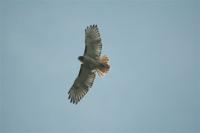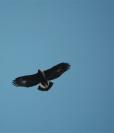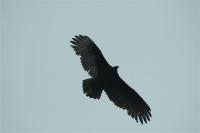You are hereRaptor Migrations
Raptor Migrations
How Raptors Migrate
Migrating raptors employ several strategies and technique during their spring and autumn migrations flying over, and/or along, portions of the Kittatinny-Shawangunk Ridge and Corridor with its 250-mile-long northeast-to-southwest orientation in New York, New Jersey and Pennsylvania. By understanding these factors, a person’s chances of seeing good raptor migrations are improved.
General Weather Conditions
General weather conditions, and local wind conditions, are especially relevant factors influencing raptor migrations. By looking at weather maps published in newspapers and broadcast on television one can more or less determine the best times to visit raptor migration watchsites along the Kittatinny-Shawangunk Ridge.
Spring raptor migrations across and/or along the Kittatinny-Shawangunk Ridge and Corridor do not contain as many birds as during autumn. They tend to contain the largest numbers of birds on days with southerly winds and a drop in barometric pressure, rising air temperatures, and the approach from the West of a cold front. Spring hawk flights also often tend to cross the area at higher altitudes than during autumn.
Autumn raptor migrations frequently occur when a notable low-pressure area covers southern New England and upstate New York, and a cold front crosses the Kittatinny-Shawangunk Ridge and Corridor several days later. Strong northwest winds typically occur during these conditions which provide ideal flight conditions for migrating raptors which are experts at using favorable air currents caused by northwest winds.
At certain watchsites such as Bake Oven Knob, however, southwest winds sometimes also produce excellent flights of Sharp-shinned Hawks and Red-tailed Hawks. Migrating Ospreys, Bald Eagles, and Golden Eagles also sometimes pass close to that site on southwest winds giving hawk watchers superb views of these birds. Hence the importance of southwest winds during autumn varies depending on the local topography of each individual watchsite.
Deflective Updrafts
When strong northwest winds occur along the Kittatinny-Shawangunk Ridge after the passage of a cold front, they strike the north flanks of the ridge and are deflected upward thus providing ideal air currents for soaring flight conditions for migrating raptors. Under these conditions, some of the larger birds such as Ospreys, Bald Eagles, and Golden Eagles tend to follow the Kittatinny-Shawangunk Ridge for many miles soaring nearly effortlessly on these ideal air currents. The diagram illustrates how raptors use deflective air currents along the Ridge.
On the other hand, during autumn at a few raptor migration watchsites along the Kittatinny Ridge in Pennsylvania, such as Bake Oven Knob, excellent and unusually close flights of Ospreys, eagles, Sharp-shinned Hawks and other accipiters, and Red-tailed Hawks and sometimes other buteos, also occur on days with prevailing southwest winds. Apparently it is the topography of the landscape at that site, which combines with wind direction to create unusually favorable raptor flight conditions there. The southwest winds phenomenon does not occur at most other sites along the Kittatinny-Shawangunk Ridge.
An Osprey, Bald Eagle, Golden Eagle, and Red-tailed Hawk soaring on deflective updrafts.
Thermals
Thermals are large, invisible bubbles of warm air that rise into the atmosphere after being generated from various locations on the landscape—large rock piles, clear cuts in woodland, paved roads and parking lots, and other places with different adjacent heat absorption and reflection characteristics.
Migrating raptors during autumn use thermal soaring frequently—especially on days without strong winds such as several days after the passage of cold fronts. Under these conditions, migrating raptors often break away from the Kittatinny-Shawangunk Ridge and drift cross-country while generally heading toward the south and southwest using thermal soaring. The diagram illustrates how hawks use thermal soaring while engaging in ridge-hopping and cross-country flight.
Although all raptors sometimes use thermal soaring (or combinations of deflective updrafts and thermal soaring), some species such as Broad-winged Hawks are especially notable users of these air currents. Sometimes hundreds of Broad-winged Hawks, called a “kettle,” are seen milling inside a thermal bubble as it rises aloft. Seeing a “kettle” of migrating Broad-wings is a spectacular sight, and eagerly looked for by hawk watchers in mid-September. At some point as the thermal bubble rises into the atmosphere it begins to dissipate in the form of cumulous clouds and the hawks that rode it aloft begin to leave and glide downward over the landscape until another thermal is found and the raptors repeat their thermal-riding process. Thus thermal soaring allows raptors to ridge-hop and engage in cross-country migrations without using much energy, and thus cover long distances relatively effortlessly. Sometimes raptors of all species use thermal soaring, but only Broad-winged Hawks form “kettles” of many dozens or hundreds of hawks inside thermals along the Kittatinny-Shawangunk Ridge and Corridor.
A "kettle" of Broad-winged Hawks, and a Red-tailed Hawk, Golden Eagle, and Turkey Vulture thermal soaring.
Leading-lines
Prominent geographic features such as the Kittatinny-Shawangunk Ridge serve as leading-lines for migrating raptors. As the birds engage in cross-country flight on some days, and encounter this famous ridge, they may encounter favorable wind conditions and are lead for varying distances along its 250 mile length. No raptors follow the ridge for its entire length, however, but on days with strong northwest winds Ospreys, Bald Eagles, and Golden Eagles may adhere to the north slope of the ridge for 80 or more miles before breaking away and heading to other ridges.
Selected References
Bildstein, Keith L.
2006 Migrating Raptors of the World: Their Ecology and Conservation. Cornell University Press, Ithaca, NY
Bildstein, Keith L., Jeff P. Smith, Ernesto Ruelas Inzunza, and Richard R. Veit
2008 State of North America’s Birds of Prey. Series Ornithology, No. 3. Nuttall Ornithological Club, Cambridge, MA and American Ornithologists’ Union, Washington, DC
Broun, Maurice
2000 Hawks Aloft: The Story of Hawk Mountain. Millennial [Sixth] Edition. Stackpole Books, Mechanicsburg, PA
Heintzelman, Donald S.
1975 Autumn Hawk Flights: The Migrations in Eastern North America. Rutgers University Press, New Brunswick, NJ
1979 A Guide to Hawk Watching in North America. Pennsylvania State University Press, University Park, PA
1986 The Migrations of Hawks. Indiana University Press, Bloomington, IN
2004a Guide to Hawk Watching in North America. Falcon Guide/Globe Pequot Press, Guilford, CT
2004b Hawks and Owls of Eastern North America. Rutgers University Press, New Brunswick, NJ
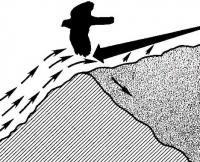
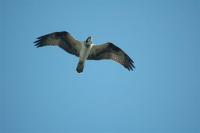
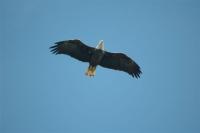
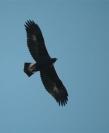
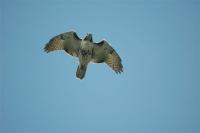

.img_assist_custom-200x130.jpg)
